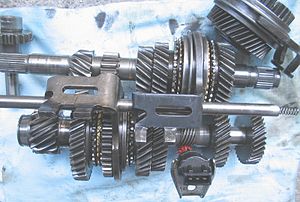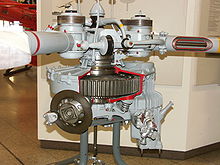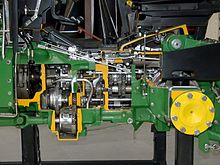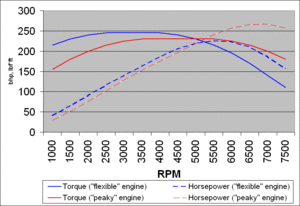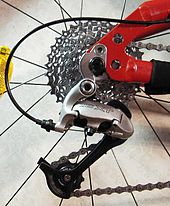- Transmission (mechanics)
-
A machine consists of a power source and a power transmission system, which provides controlled application of the power. Merriam-Webster defines transmission as: an assembly of parts including the speed-changing gears and the propeller shaft by which the power is transmitted from an engine to a live axle.[1] Often transmission refers simply to the gearbox that uses gears and gear trains to provide speed and torque conversions from a rotating power source to another device.[2][3]
In British English the term transmission refers to the whole drive train, including gearbox, clutch, prop shaft (for rear-wheel drive), differential and final drive shafts. In American English, however, the distinction is made that a gearbox is any device which converts speed and torque, whereas a transmission is a type of gearbox that can be "shifted" to dynamically change the speed:torque ratio, such as in a vehicle.
The most common use is in motor vehicles, where the transmission adapts the output of the internal combustion engine to the drive wheels. Such engines need to operate at a relatively high rotational speed, which is inappropriate for starting, stopping, and slower travel. The transmission reduces the higher engine speed to the slower wheel speed, increasing torque in the process. Transmissions are also used on pedal bicycles, fixed machines, and anywhere else rotational speed and torque needs to be adapted.
Often, a transmission will have multiple gear ratios (or simply "gears"), with the ability to switch between them as speed varies. This switching may be done manually (by the operator), or automatically. Directional (forward and reverse) control may also be provided. Single-ratio transmissions also exist, which simply change the speed and torque (and sometimes direction) of motor output.
In motor vehicle applications, the transmission will generally be connected to the crankshaft of the engine. The output of the transmission is transmitted via driveshaft to one or more differentials, which in turn drive the wheels. While a differential may also provide gear reduction, its primary purpose is to change the direction of rotation.
Conventional gear/belt transmissions are not the only mechanism for speed/torque adaptation. Alternative mechanisms include torque converters and power transformation (e.g., diesel-electric transmission, hydraulic drive system, etc.). Hybrid configurations also exist.
Contents
Explanation
Transmission types Manual Automatic Semi-automatic Continuously variable Bicycle gearing Early transmissions included the right-angle drives and other gearing in windmills, horse-powered devices, and steam engines, in support of pumping, milling, and hoisting.
Most modern gearboxes are used to increase torque while reducing the speed of a prime mover output shaft (e.g. a motor crankshaft). This means that the output shaft of a gearbox will rotate at a slower rate than the input shaft, and this reduction in speed will produce a mechanical advantage, causing an increase in torque. A gearbox can be set up to do the opposite and provide an increase in shaft speed with a reduction of torque. Some of the simplest gearboxes merely change the physical direction in which power is transmitted.
Many typical automobile transmissions include the ability to select one of several different gear ratios. In this case, most of the gear ratios (often simply called "gears") are used to slow down the output speed of the engine and increase torque. However, the highest gears may be "overdrive" types that increase the output speed.
Uses
Gearboxes have found use in a wide variety of different—often stationary—applications, such as wind turbines.
Transmissions are also used in agricultural, industrial, construction, mining and automotive equipment. In addition to ordinary transmission equipped with gears, such equipment makes extensive use of the hydrostatic drive and electrical adjustable-speed drives.
Simple
The simplest transmissions, often called gearboxes to reflect their simplicity (although complex systems are also called gearboxes in the vernacular), provide gear reduction (or, more rarely, an increase in speed), sometimes in conjunction with a right-angle change in direction of the shaft (typically in helicopters, see picture). These are often used on PTO-powered agricultural equipment, since the axial PTO shaft is at odds with the usual need for the driven shaft, which is either vertical (as with rotary mowers), or horizontally extending from one side of the implement to another (as with manure spreaders, flail mowers, and forage wagons). More complex equipment, such as silage choppers and snowblowers, have drives with outputs in more than one direction.
The gearbox in a wind turbine converts the slow, high-torque rotation of the turbine into much faster rotation of the electrical generator. These are much larger and more complicated than the PTO gearboxes in farm equipment. They weigh several tons and typically contain three stages to achieve an overall gear ratio from 40:1 to over 100:1, depending on the size of the turbine. (For aerodynamic and structural reasons, larger turbines have to turn more slowly, but the generators all have to rotate at similar speeds of several thousand rpm.) The first stage of the gearbox is usually a planetary gear, for compactness, and to distribute the enormous torque of the turbine over more teeth of the low-speed shaft.[4] Durability of these gearboxes has been a serious problem for a long time.[5]
Regardless of where they are used, these simple transmissions all share an important feature: the gear ratio cannot be changed during use. It is fixed at the time the transmission is constructed.
For transmission types that overcome this issue, see Continuously Variable Transmission, also known as CVT.
Multi-ratio systems
Many applications require the availability of multiple gear ratios. Often, this is to ease the starting and stopping of a mechanical system, though another important need is that of maintaining good fuel efficiency.
Automotive basics
The need for a transmission in an automobile is a consequence of the characteristics of the internal combustion engine. Engines typically operate over a range of 600 to about 7000 revolutions per minute (though this varies, and is typically less for diesel engines), while the car's wheels rotate between 0 rpm and around 1800 rpm.
Furthermore, the engine provides its highest torque and power outputs unevenly across the rev range resulting in a torque band and a power band. Often the greatest torque is required when the vehicle is moving from rest or traveling slowly, while maximum power is needed at high speed. Therefore, a system that transforms the engine's output so that it can supply high torque at low speeds, but also operate at highway speeds with the motor still operating within its limits, is required. Transmissions perform this transformation.
The dynamics of a car vary with speed: at low speeds, acceleration is limited by the inertia of vehicular gross mass; while at cruising or maximum speeds wind resistance is the dominant barrier. In the former torque is required to overcome inertia, in the latter power is needed to keep the car from being slowed down by wind resistance.
Many transmissions and gears used in automotive and truck applications are contained in a cast iron case, though more frequently aluminium is used for lower weight especially in cars. There are usually three shafts: a mainshaft, a countershaft, and an idler shaft.
The mainshaft extends outside the case in both directions: the input shaft towards the engine, and the output shaft towards the rear axle (on rear wheel drive cars- front wheel drives generally have the engine and transmission mounted transversely, the differential being part of the transmission assembly.) The shaft is suspended by the main bearings, and is split towards the input end. At the point of the split, a pilot bearing holds the shafts together. The gears and clutches ride on the mainshaft, the gears being free to turn relative to the mainshaft except when engaged by the clutches.
Types of automobile transmissions include manual, automatic or semi-automatic transmission.
Manual
Manual transmission come in two basic types:
- a simple but rugged sliding-mesh or unsynchronized / non-synchronous system, where straight-cut spur gear sets are spinning freely, and must be synchronized by the operator matching engine revs to road speed, to avoid noisy and damaging "gear clash",
- and the now common constant-mesh gearboxes which can include non-synchronised, or synchronized / synchromesh systems, where diagonal cut helical (and sometimes double-helical) gear sets are constantly "meshed" together, and a dog clutch is used for changing gears. On synchromesh boxes, friction cones or "synchro-rings" are used in addition to the dog clutch.
The former type is commonly found in many forms of racing cars, older heavy-duty trucks, and some agricultural equipment.
Manual transmissions are the most common type outside North America and Australia. They are cheaper, lighter, usually give better performance, and fuel efficiency (although automatic transmissions with torque converter lockup and advanced electronic controls can provide similar results). It is customary for new drivers to learn, and be tested, on a car with a manual gear change. In Malaysia and Denmark all cars used for testing (and because of that, virtually all those used for instruction as well) have a manual transmission. In Japan, the Philippines, Germany, Poland, Italy, Israel, the Netherlands, Belgium, New Zealand, Austria, Bulgaria, the UK,[6][7] Ireland,[7] Sweden, Estonia, France, Spain, Switzerland, the Australian states of Victoria, Western Australia and Queensland, Finland and Lithuania, a test pass using an automatic car does not entitle the driver to use a manual car on the public road; a test with a manual car is required.[citation needed] Manual transmissions are much more common than automatic transmissions in Asia, Africa, South America and Europe.
Many manual transmissions include both synchronized and unsynchronized gearing; it is not uncommon for the first/reverse gear to lack synchros. Those gears are meant to be shifted into only when the vehicle is stopped.
Some manual transmissions have an extremely low ratio for first gear, which is referred to as a "creeper gear" or "granny gear". Such gears are usually not synchronized. This feature is common on pickup trucks tailored to trailer-towing, farming, or construction-site work. During normal on-road use, the truck is usually driven without using the creeper gear at all, and second gear is used from a standing start.
Non-synchronous
Main article: Non-synchronous transmissionsThere are commercial applications engineered with designs taking into account that the gear shifting will be done by an experienced operator. They are a manual transmission, but are known as non-synchronized transmissions. Dependent on country of operation, many local, regional, and national laws govern the operation of these types of vehicles (see Commercial Driver's License). This class may include commercial, military, agricultural, or engineering vehicles. Some of these may use combinations of types for multi-purpose functions. An example would be a power take-off (PTO) gear. The non-synchronous transmission type requires an understanding of gear range, torque, engine power, and multi-functional clutch and shifter functions. Also see Double-clutching, and Clutch-brake sections of the main article.
Automatic
Most modern North American and Australian and many larger, high specification European and Japanese cars have an automatic transmission that will select an appropriate gear ratio without any operator intervention. They primarily use hydraulics to select gears, depending on pressure exerted by fluid within the transmission assembly. Rather than using a clutch to engage the transmission, a fluid flywheel, or torque converter is placed in between the engine and transmission. It is possible for the driver to control the number of gears in use or select reverse, though precise control of which gear is in use may or may not be possible.
Automatic transmissions are easy to use. However, in the past, automatic transmissions of this type have had a number of problems; they were complex and expensive, sometimes had reliability problems (which sometimes caused more expenses in repair), have often been less fuel-efficient than their manual counterparts (due to "slippage" in the torque converter), and their shift time was slower than a manual making them uncompetitive for racing. With the advancement of modern automatic transmissions this has changed.[citation needed]
Attempts to improve the fuel efficiency of automatic transmissions include the use of torque converters which lock up beyond a certain speed, or in the higher gear ratios, eliminating power loss, and overdrive gears which automatically actuate above certain speeds; in older transmissions both technologies could sometimes become intrusive, when conditions are such that they repeatedly cut in and out as speed and such load factors as grade or wind vary slightly. Current computerized transmissions possess very complex programming to both maximize fuel efficiency and eliminate any intrusiveness, and we are at a point in technological advancement where automatics are beginning to outperform manuals in both performance and efficiency.[citation needed] This is due to electronic advances however, rather than mechanical ones.
For certain applications, the slippage inherent in automatic transmissions can be advantageous; for instance, in drag racing, the automatic transmission allows the car to be stopped with the engine at a high rpm (the "stall speed") to allow for a very quick launch when the brakes are released; in fact, a common modification is to increase the stall speed of the transmission. This is even more advantageous for turbocharged engines, where the turbocharger needs to be kept spinning at high rpm by a large flow of exhaust in order to keep the boost pressure up and eliminate the turbo lag that occurs when the engine is idling and the throttle is suddenly opened.
Semi-automatic
The creation of computer control also allowed for a sort of cross-breed transmission where the car handles manipulation of the clutch automatically, but the driver can still select the gear manually if desired. This is sometimes called a "clutchless manual," or "automated manual" transmission. Many of these transmissions allow the driver to give full control to the computer. They are generally designed using manual transmission "internals", and when used in passenger cars, have synchromesh operated helical constant mesh gear sets.
Specific type of this transmission includes: Easytronic, and Geartronic.
A "dual-clutch" transmission uses two sets of internals which are alternately used, each with its own clutch, so that only the clutches are used during the actual "gearchange".
Specific type of this transmission includes: Direct-Shift Gearbox.
There are also sequential transmissions which use the rotation of a drum to switch gears.[8]
Bicycle gearing
Bicycles usually have a system for selecting different gear ratios. There are two main types: derailleur gears and hub gears. The derailleur type is the most common, and the most visible, using sprocket gears. Typically there are several gears available on the rear sprocket assembly, attached to the rear wheel. A few more sprockets are usually added to the front assembly as well. Multiplying the number of sprocket gears in front by the number to the rear gives the number of gear ratios, often called "speeds".
Hub gears use epicyclic gearing and are enclosed within the axle of the rear wheel. Because of the small space, they typically offer fewer different speeds, although at least one has reached 14 gear ratios and Fallbrook Technologies manufactures a transmission with technically infinite ratios.[9]
Causes for failure of bicycle gearing include: worn teeth, damage caused by a faulty chain, damage due to thermal expansion, broken teeth due to excessive pedaling force, interference by foreign objects, and loss of lubrication due to negligence.
Uncommon types
Dual clutch transmission
This arrangement is also sometimes known as a direct shift gearbox or powershift gearbox. It seeks to combine the advantages of a conventional manual shift with the qualities of a modern automatic transmission by providing different clutches for odd and even speed selector gears. When changing gear, the engine torque is transferred from one gear to the other continuously, so providing gentle, smooth gear changes without either losing power or jerking the vehicle. Gear selection may be manual, automatic (depending on throttle/speed sensors), or a 'sports' version combining both options.
Continuously variable
The Continuously Variable Transmission (CVT) is a transmission in which the ratio of the rotational speeds of two shafts, as the input shaft and output shaft of a vehicle or other machine, can be varied continuously within a given range, providing an infinite number of possible ratios.
The CVT should not be confused with the Infinitely Variable Transmission (IVT) (See below).
The other mechanical transmissions described above only allow a few different gear ratios to be selected, but this type of transmission essentially has an infinite number of ratios available within a finite range. The CVT allows the relationship between the speed of the engine and the speed of the wheels to be selected within a continuous range. This can provide even better fuel economy if the engine is constantly running at a single speed. The transmission is in theory capable of a better user experience, without the rise and fall in speed of an engine, and the jerk felt when poorly changing gears.
Infinitely variable
The IVT is a specific type of CVT that has an infinite range of input/output ratios in addition to its infinite number of possible ratios; this qualification for the IVT implies that its range of ratios includes a zero output/input ratio that can be continuously approached from a defined 'higher' ratio. A zero output implies an infinite input, which can be continuously approached from a given finite input value with an IVT. [Note: so-called 'low' gears are a reference to low ratios of output/input, which have high input/output ratios that are taken to the extreme with IVTs, resulting in a 'neutral', or non-driving 'low' gear limit.]
Most (if not all) IVTs result from the combination of a CVT with an epicyclic gear system (which is also known as a planetary gear system) that facilitates the subtraction of one speed from another speed within the set of input and planetary gear rotations. This subtraction only needs to result in a continuous range of values that includes a zero output; the maximum output/input ratio can be arbitrarily chosen from infinite practical possibilities through selection of extraneous input or output gear, pulley or sprocket sizes without affecting the zero output or the continuity of the whole system. Importantly, the IVT is distinguished as being 'infinite' in its ratio of high gear to low gear within its range; high gear is infinite times higher than low gear. The IVT is always engaged, even during its zero output adjustment.
The term 'infinitely variable transmission' does not imply reverse direction, disengagement, automatic operation, or any other quality except ratio selectability within a continuous range of input/output ratios from a defined minimum to an undefined, 'infinite' maximum. This means continuous range from a defined output/input to zero output/input ratio.
Electric variable
The Electric Variable Transmission (EVT) is a transmission that achieves CVT action and in addition can use separate power inputs to produce one output. An EVT is usually designed around an epicyclic differential gear system (also known as a planetary gear system). The epicyclic gear acts as a differential, performing a "power-split" function; a portion of the mechanical power is carried directly through the gear set (the "mechanical path"). The rest of the power is converted to and from electrical energy by electric motor-generators (the "electrical path"). Hence, the EVT is a class of Power Split Transmission (PST).
Many EVTs are linked to batteries or other electrical energy storage devices. This enables them to store or draw electrical power for better operation under various conditions.
The pair of motor/generators forms an Electric Transmission in its own right, but at a lower capacity, than the EVT it is contained within. Generally the Electric Transmission capacity within the EVT is a quarter to a half of the capacity of the EVT. An EVT is often preferable to a pure electrical transmission because the mechanical transmission is cheaper, more compact, and more efficient than the electrical path.
The EVT linked to a battery is the essential method for transmitting power in some hybrid vehicles, enabling an Internal Combustion Engine (ICE) to be used in conjunction with motor/generators for vehicle propulsion. Vehicle speed is controlled primarily by adjusting the amount of power flowing through the electrical as opposed to the mechanical path. The EVT may be used to generate electrical power for storage in a battery, especially through 'regenerative braking' during deceleration. Various configurations of power generation, usage and balance can be implemented with an EVT, enabling great flexibility in propelling hybrid vehicles.
The Toyota single mode hybrid and General Motor 2 Mode hybrid are production systems that use EVTs. The Toyota system is in the Prius, Highlander, and Lexus RX400h and GS450h models. The GM system is used in the Allison Bus hybrid powertrains and the Tahoe and Yukon models. The Toyota system uses one power-split epicyclic differential gearing system over all driving conditions and is sized with an electrical path rated at approximately half the capacity of the EVT. The GM system uses two different EVT ranges: one designed for lower speeds with greater mechanical advantage, and one designed for higher speeds. The electrical path is rated at approximately a quarter of the capacity of the EVT. Other arrangements are possible and applications of EVTs are growing rapidly in number and variety.
EVTs are capable of continuously modulating output/input speed ratios like mechanical CVTs, but offer the distinct difference and benefit of being able to also apportion power from two different sources to one output.
Hydrostatic
Hydrostatic transmissions transmit all power hydraulically, using the components of hydraulic machinery. Hydrostatic transmissions do not make use of the hydrodynamic forces of the fluid flow. There is no solid coupling of the input and output. The transmission input drive is a central hydraulic pump and final drive unit(s) is/are a hydraulic motor, or hydraulic cylinder (see:swashplate). Both components can be placed physically far apart on the machine, being connected only by flexible hoses. Hydrostatic drive systems are used on excavators, lawn tractors, forklifts, winch drive systems, heavy lift equipment, agricultural machinery, earth-moving equipment, etc. An arrangement for motor-vehicle transmission was probably used on the Ferguson F-1 P99 racing car in about 1961.
The Human Friendly Transmission of the Honda DN-01 is hydrostatic.
Hydrodynamic
If the hydraulic pump and/or hydraulic motor make use of the hydrodynamic effects of the fluid flow, i.e. pressure due to a change in the fluid's momentum as it flows through vanes in a turbine. The pump and motor usually consist of rotating vanes without seals and are typically placed in close proximity. The transmission ratio can be made to vary by means of additional rotating vanes, an effect similar to varying the pitch of an airplane propeller.
The torque converter in most automotive automatic transmissions is, in itself, a hydrodynamic transmission.
It was possible to drive the Dynaflow transmission without shifting the mechanical gears.
Hydrodynamic transmissions are used in many passenger rail vehicles. In this application the advantage of smooth power delivery may outweigh the reduced efficiency caused by turbulence energy losses in the fluid.
Electric
Electric transmissions convert the mechanical power of the engine(s) to electricity with electric generators and convert it back to mechanical power with electric motors. Electrical or electronic adjustable-speed drive control systems are used to control the speed and torque of the motors. If the generators are driven by turbines, such arrangements are called turbo-electric. Likewise installations powered by diesel-engines are called diesel-electric. Diesel-electric arrangements are used on many railway locomotives, ships, large mining trucks, and some bulldozers.
Virtual transmission
Virtual Transmission allows for the same traction motor to be both a low-speed high torque and high-speed electric motor, using the winding/software that runs on the new electric motors.[10] This virtual transmission will require less complex engineering, and less weight. The alternator and starter for the Chevrolet Volt can be combined into a single armature, smaller and lighter than each alternator and starter individually.
See also
References
- ^ http://www.merriam-webster.com/dictionary/transmission Merriam-Webster definition of transmission
- ^ J. J. Uicker, G. R. Pennock, and J. E. Shigley, 2003, Theory of Machines and Mechanisms, Oxford University Press, New York.
- ^ B. Paul, 1979, Kinematics and Dynamics of Planar Machinery, Prentice Hall.
- ^ Stiesdal, Henrik (August 1999), The wind turbine: Components and operation, http://www.windmission.dk/workshop/BonusTurbine.pdf, retrieved 2009-10-06.
- ^ Musial, W.; Butterfield, S.; McNiff, B. (May 2007), National Renewable Energy Laboratory, http://www.nrel.gov/wind/pdfs/41548.pdf.
- ^ Practical Driving Test FAQs
- ^ a b Graduated Licensing: Is it what it's meant to be?
- ^ [1] Howstuffworks.com
- ^ Rohloff 14-speed hub
- ^ http://www.choruscars.com/tech_summary.shtml
External links
Gear systems Spur gear systems • Worm drive • Rack and pinion • Epicyclic (planetary) gearing • Sun and planet gear • Harmonic drive • Cycloidal drive • Non-circular gearGear shapes Geartooth profiles Gear mechanics Transmission • Differential • Gear coupling • Gear train • Bicycle gearing • Continuously variable transmission • Offset (gears)Examples In Bicycles: Cogset • Derailleur gears • Hub gear • Shaft-driven bicycle • Sprocket
In Horology: Wheel trainSee also Categories:- Mechanical engineering
- Machines
- Kinematics
- Mechanisms
- Gears
- Mechanical power transmission
- Automobile transmissions
Wikimedia Foundation. 2010.

